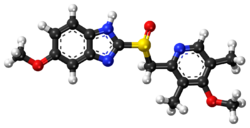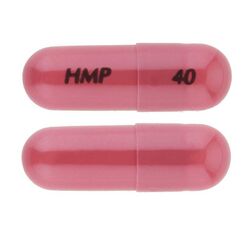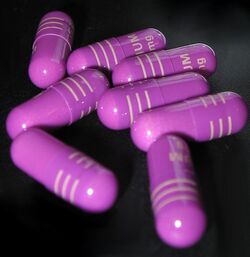Chemistry:Esomeprazole
 | |
 | |
| Clinical data | |
|---|---|
| Pronunciation | /ˌɛsoʊˈmɛprəˌzoʊl, -ˈmiː-, -ˌzɒl/[1] |
| Trade names | Nexium, others[2] |
| AHFS/Drugs.com | Monograph |
| MedlinePlus | a699054 |
| License data |
|
| Pregnancy category |
|
| Routes of administration | By mouth, intravenous |
| Drug class | Proton pump inhibitor |
| ATC code | |
| Legal status | |
| Legal status | |
| Pharmacokinetic data | |
| Bioavailability | 50 to 90% |
| Metabolism | Liver (CYP2C19, CYP3A4) |
| Elimination half-life | 1–1.5 hours |
| Excretion | 80% Kidney 20% Feces |
| Identifiers | |
| |
| CAS Number | |
| PubChem CID | |
| DrugBank | |
| ChemSpider | |
| UNII | |
| KEGG | |
| ChEBI | |
| ChEMBL | |
| Chemical and physical data | |
| Formula | C17H19N3O3S |
| Molar mass | 345.42 g·mol−1 |
| 3D model (JSmol) | |
| |
| |
| | |
Esomeprazole, sold under the brand name Nexium [or Neksium] among others,[2] is a medication which reduces stomach acid.[10] It is used to treat gastroesophageal reflux disease, peptic ulcer disease, and Zollinger–Ellison syndrome.[10][11] Its effectiveness is similar to that of other proton pump inhibitors (PPIs).[12] It is taken by mouth or injection into a vein.[10]
Common side effects include headache, constipation, dry mouth, and abdominal pain.[10] Serious side effects may include angioedema, Clostridium difficile infection, and pneumonia.[10] Use in pregnancy appears to be safe, while safety during breastfeeding is unclear.[3] Esomeprazole is the (S)-(−)-enantiomer (or less specifically the S-isomer) of omeprazole.[10][lower-alpha 1] It works by blocking H+/K+-ATPase in the parietal cells of the stomach.[10]
It was patented in 1993 and approved for medical use in 2000.[13] It is available as a generic medication and sold over the counter in a number of countries.[14][11] In 2020, it was the 122nd most commonly prescribed medication in the United States, with more than 5 million prescriptions.[15][16] It is also available in lower dose formulations without a prescription in the United States,[17] the United Kingdom[18] as well as Australia, Canada and New Zealand.[19]
Medical use
The primary uses of esomeprazole are gastroesophageal reflux disease, treatment and maintenance of erosive esophagitis, treatment of duodenal ulcers caused by H. pylori, prevention of gastric ulcers in those on chronic NSAID therapy, and treatment of gastrointestinal ulcers associated with Crohn's disease.[20][21]
Gastroesophageal reflux disease
Gastroesophageal reflux disease (GERD) is a condition in which the digestive acid in the stomach comes in contact with the esophagus. The irritation caused by this disorder is known as heartburn.[22] Long-term contact between gastric acids and the esophagus can cause permanent damage to the esophagus and is associated with Barrett's esophagus.[23] Esomeprazole reduces the production of digestive acids, thus reducing their effect on the esophagus.
Duodenal ulcers
Esomeprazole is combined with the antibiotics clarithromycin and amoxicillin (or metronidazole instead of amoxicillin in penicillin-hypersensitive patients) in a 10-day eradication triple therapy for Helicobacter pylori. Infection by H. pylori is a causative factor in the majority of peptic and duodenal ulcers.
Efficacy
A 2006 meta analysis concluded that compared to other proton pump inhibitors, esomeprazole confers a modest overall benefit in esophageal healing and symptom relief. When broken down by disease severity, the benefit of esomeprazole relative to other proton pump inhibitors was negligible in people with mild disease (number needed to treat 50[clarification needed]), but appeared more in those with severe disease (number needed to treat 8[clarification needed]).[24] A second meta analysis also found increases in erosive esophageal healing (>95% healing rate) when compared to standardized doses in broadly selected patient populations.[25] A 2017 study found esomeprazole to be among a number of effective PPIs.[26]
Adverse effects
Common side effects include headache, diarrhea, nausea, flatulence, decreased appetite, constipation, dry mouth, and abdominal pain. More severe side effects are severe allergic reactions, chest pain, dark urine, fast heartbeat, fever, paresthesia, persistent sore throat, severe stomach pain, unusual bruising or bleeding, unusual tiredness, and yellowing of the eyes or skin.[27]
Proton pump inhibitors may be associated with a greater risk of hip fractures[28] and Clostridium difficile-associated diarrhoea.[29] Patients are frequently administered the drugs in intensive care as a protective measure against ulcers, but this use is also associated with a 30% increase in occurrence of pneumonia.[30]
Long-term use of proton pump inhibitors in patients treated for Helicobacter pylori has been shown to dramatically increase the risk of gastric cancer.[31]
Acute tubulointerstitial nephritis is a possible adverse reaction when using proton pump inhibitors.[8]
Interactions
Esomeprazole is a competitive inhibitor of the enzyme CYP2C19, and may therefore interact with drugs that depend on it for metabolism, such as diazepam and warfarin; the concentrations of these drugs may increase if they are used concomitantly with esomeprazole.[32] Conversely, clopidogrel (Plavix) is an inactive prodrug that partially depends on CYP2C19 for conversion to its active form; inhibition of CYP2C19 blocks the activation of clopidogrel, thus reducing its effects.[33][34]
Drugs that depend on stomach pH for absorption may interact with esomeprazole; drugs that depend on an acidic environment (such as ketoconazole or atazanavir) will be poorly absorbed, whereas drugs that are broken down in acidic environments (such as erythromycin) will be absorbed to a greater extent than normal.[32]
Pharmacokinetics
Single 20 to 40 mg oral doses generally give rise to peak plasma esomeprazole concentrations of 0.5-1.0 mg/L within 1–4 hours, but after several days of once-daily administration, these levels may increase by about 50%. A 30-minute intravenous infusion of a similar dose usually produces peak plasma levels on the order of 1–3 mg/L. The drug is rapidly cleared from the body, largely by urinary excretion of pharmacologically inactive metabolites such as 5-hydroxymethylesomeprazole and 5-carboxyesomeprazole. Esomeprazole and its metabolites are analytically indistinguishable from omeprazole and the corresponding omeprazole metabolites unless chiral techniques are employed.[35]
Dosage forms


Esomeprazole is available as delayed-release capsules in the United States or as delayed-release tablets in Australia, the United Kingdom, and Canada (containing esomeprazole magnesium) in strengths of 20 and 40 mg, as delayed-release capsules in the United States (containing esomeprazole strontium) in a 49.3 mg strength (delivering the equivalent of 40 mg of esomeprazole,[36] and as esomeprazole sodium for intravenous injection/infusion. Oral esomeprazole preparations are enteric-coated, due to the rapid degradation of the drug in the acidic conditions of the stomach. This is achieved by formulating capsules using the multiple-unit pellet system.
The combination naproxen/esomeprazole magnesium (brand name Vimovo) is used for the prevention of gastric ulcers associated with chronic NSAID therapy. Vimovo is available in two dosage strengths: 500/20 mg and 375/20 mg. Clinical trials of naproxen/esomeprazole demonstrated an incidence of GI ulcer in 24% of patients on naproxen (alone) versus 7% on naproxen/esomeprazole.[37] The FDA has added warnings to the label for Vimovo concerning acute interstitial nephritis and risk of kidney problems in some patients.[38]
Multiple-unit pellet system
Esomeprazole capsules, as well as Losec/Prilosec tablets, are formulated as a "multiple-unit pellet system" (MUPS). Essentially, the capsule consists of extremely small enteric-coated granules (pellets) of the esomeprazole formulation inside an outer shell. When the capsule is immersed in an aqueous solution, as happens when the capsule reaches the stomach, water enters the capsule by osmosis. The contents swell from water absorption, causing the shell to burst, and releasing the enteric-coated granules. For most patients, the multiple-unit pellet system is of no advantage over conventional enteric-coated preparations. Patients for whom the formulation is of benefit include those requiring nasogastric tube feeding and those with difficulty swallowing (dysphagia).[39][40][41][42]
Society and culture
Global distribution
In 2010, AstraZeneca announced a co-promotion agreement with Daiichi Sankyo to distribute Nexium in Japan.[43] In September 2011, Nexium was approved for sale and was launched by Daiichi Sankyo in Japan.[44] Esomeprazole was approved for use in the United States in February 2001.[45][46]
Economics
Between the launch of esomeprazole in 2001 and 2005, the drug netted AstraZeneca about $14.4 billion.[47]
Controversy
There has been some controversy about AstraZeneca's behaviour in creating, patenting, and marketing the drug. Esomeprazole's successful predecessor, omeprazole, is a mixture of two mirror-imaged molecules (esomeprazole which is the S-enantiomer, and R-omeprazole); critics said the company was trying to "evergreen" its omeprazole patent by patenting the pure esomeprazole and aggressively marketing to doctors that it is more effective than the mixture.[48]
Brand names
Generic versions of esomeprazole magnesium are available worldwide.[2] It is available over-the-counter under the brand name Nexium in the United States[17][49] and the UK.[50]
Veterinary use
Injection formulations of esomeprazole are used for gastroprotection in veterinary medicine. In goats administered the drug by intravenous or subcutaneous injection rapid elimination was noted.[51] In that study the sulfone metabolite was detectable for several hours after injection of the parent drug.
Other uses
Esomeprazole can be used as a parasiticide.[52] Gokmen et al., 2016 screen for efficacy against Trichomonas vaginalis isolates from horses.[52] They found esomeprazole to be effective as a veterinary antiparasitic.[52]
Footnotes
- ↑ The name thus is an onomatopoeia, as it can also be read as Es + omeprazole
References
- ↑ "Esomeprazole". Merriam-Webster Dictionary. https://www.merriam-webster.com/dictionary/Esomeprazole. Retrieved 21 January 2016.
- ↑ 2.0 2.1 2.2 "Esomeprazole Brand Names". BDdrugs.com. Bangladesh. 2011. http://www.bddrugs.com/product5.php?idn=5&prev=&prev1=&prev2=.
- ↑ 3.0 3.1 "Esomeprazole Pregnancy and Breastfeeding Warnings". https://www.drugs.com/pregnancy/esomeprazole.html.
- ↑ "Esomeprazole". 15 September 2017. https://www.tga.gov.au/book-page/14-esomeprazole.
- ↑ "Toreso/Esocolam/Meprator/Esotor/Nesed/Esome/Esotrack (Torrent Australasia Pty Ltd)". 16 February 2023. https://www.tga.gov.au/resources/prescription-medicines-registrations/toresoesocolammepratoresotornesedesomeesotrack-torrent-australasia-pty-ltd.
- ↑ "Nexium- esomeprazole magnesium capsule, delayed release Nexium- esomeprazole magnesium granule, delayed release". DailyMed. U.S. Library of Medicine. 7 June 2018. https://dailymed.nlm.nih.gov/dailymed/drugInfo.cfm?setid=f4853677-1622-4037-688b-fdf533a11d96.
- ↑ "Nexium 24HR- esomeprazole magnesium capsule, delayed release Nexium 24HR ClearMinis- esomeprazole magnesium capsule, delayed release". 26 May 2020. https://dailymed.nlm.nih.gov/dailymed/drugInfo.cfm?setid=4513934d-0cf0-40fc-a348-b4e75a33b094.
- ↑ 8.0 8.1 "Nexium I.V.- esomeprazole sodium injection". DailyMed. U.S. Library of Medicine. 27 November 2020. https://dailymed.nlm.nih.gov/dailymed/drugInfo.cfm?setid=c325bbfc-46f3-471e-7bbc-ed0d6965d13b.
- ↑ "Nexium Control EPAR". 17 September 2018. https://www.ema.europa.eu/en/medicines/human/EPAR/nexium-control.
- ↑ 10.0 10.1 10.2 10.3 10.4 10.5 10.6 "Esomeprazole Magnesium Monograph for Professionals". American Society of Health-System Pharmacists. https://www.drugs.com/monograph/esomeprazole-magnesium.html.
- ↑ 11.0 11.1 British national formulary : BNF 76 (76 ed.). Pharmaceutical Press. 2018. pp. 78. ISBN 978-0-85711-338-2.
- ↑ "[99 Comparative effectiveness of proton pump inhibitors | Therapeutics Initiative"]. 28 June 2016. http://www.ti.ubc.ca/2016/06/28/99-comparative-effectiveness-proton-pump-inhibitors/.
- ↑ Analogue-based Drug Discovery. John Wiley & Sons. 2006. p. 445. ISBN 978-3-527-60749-5. https://books.google.com/books?id=FjKfqkaKkAAC&pg=PA445.
- ↑ 2018 Nurse's Drug Handbook. Jones & Bartlett Learning. 2017. p. 394. ISBN 978-1-284-12134-6. https://books.google.com/books?id=rD1DDwAAQBAJ&pg=PA394.
- ↑ "The Top 300 of 2020". https://clincalc.com/DrugStats/Top300Drugs.aspx.
- ↑ "Esomeprazole - Drug Usage Statistics". https://clincalc.com/DrugStats/Drugs/Esomeprazole.
- ↑ 17.0 17.1 "Esomeprazole". United States National Library of Medicine. https://medlineplus.gov/druginfo/meds/a699054.html.
- ↑ "About esomeprazole". 13 January 2022. https://www.nhs.uk/medicines/esomeprazole/about-esomeprazole/.
- ↑ "Australian TGA Scheduling of Esomeprazole". 15 September 2017. https://www.tga.gov.au/resources/publication/scheduling-decisions-interim/scheduling-delegates-interim-decisions-and-invitation-further-comment-accsacms-march-and-july-2017/14-esomeprazole/.
- ↑ "Esomeprazole Magnesium". The American Society of Health-System Pharmacists. https://www.drugs.com/monograph/esomeprazole-magnesium.html.
- ↑ "Pharmacokinetic properties of esomeprazole in adolescent patients aged 12 to 17 years with symptoms of gastroesophageal reflux disease: A randomized, open-label study". Clin Ther 28 (3): 419–27. March 2006. doi:10.1016/j.clinthera.2006.03.010. PMID 16750456.
- ↑ "Gastroesophageal Reflux Disease". https://www.lecturio.com/concepts/gastroesophageal-reflux-disease/.
- ↑ "Barrett's Esophagus". 8 February 2023. https://www.mayoclinic.org/diseases-conditions/barretts-esophagus/symptoms-causes/syc-20352841/.
- ↑ "Esomeprazole versus other proton pump inhibitors in erosive esophagitis: a meta-analysis of randomized clinical trials". Clin. Gastroenterol. Hepatol. 4 (12): 1452–8. December 2006. doi:10.1016/j.cgh.2006.09.013. PMID 17162239.
- ↑ "Systematic review: proton pump inhibitors (PPIs) for the healing of reflux oesophagitis - a comparison of esomeprazole with other PPIs". Aliment. Pharmacol. Ther. 24 (5): 743–50. September 2006. doi:10.1111/j.1365-2036.2006.03074.x. PMID 16918878.
- ↑ "Comparative effectiveness and acceptability of the FDA-licensed proton pump inhibitors for erosive esophagitis". Medicine 96 (39): e8120. 2017. doi:10.1097/md.0000000000008120. ISSN 0025-7974. PMID 28953640.
- ↑ "Nexium side effects". Drug information online. Drugs.com. https://www.drugs.com/sfx/nexium-side-effects.html.
- ↑ "Long-term proton pump inhibitor therapy and risk of hip fracture". JAMA 296 (24): 2947–53. 2006. doi:10.1001/jama.296.24.2947. PMID 17190895.
- ↑ "Proton pump inhibitors and Clostridium difficile". Bandolier. 2003. http://www.medicine.ox.ac.uk/bandolier/booth/Pharmacy/PPIcdiff.html.
- ↑ "Acid-suppressive medication use and the risk for hospital-acquired pneumonia". JAMA 301 (20): 2120–8. 2009. doi:10.1001/jama.2009.722. PMID 19470989.
- ↑ "Long-term proton pump inhibitors and risk of gastric cancer development after treatment for Helicobacter pylori: a population-based study". Gut 67 (1): 28–35. January 2018. doi:10.1136/gutjnl-2017-314605. PMID 29089382.
- ↑ 32.0 32.1 "Review article: comparison of the pharmacokinetics, acid suppression and efficacy of proton pump inhibitors". Aliment. Pharmacol. Ther. 14 (8): 963–78. August 2000. doi:10.1046/j.1365-2036.2000.00788.x. PMID 10930890.
- ↑ "The drug-drug interaction between proton pump inhibitors and clopidogrel". CMAJ 180 (7): 699–700. March 2009. doi:10.1503/cmaj.090251. PMID 19332744.
- ↑ "Drug-drug interaction between clopidogrel and the proton pump inhibitors". Ann Pharmacother 43 (7): 1266–74. July 2009. doi:10.1345/aph.1M051. PMID 19470853.
- ↑ Baselt RC (2008). Disposition of toxic drugs and chemicals in man (8th ed.). Foster City, Ca: Biomedical Publications. pp. 388–389. ISBN 978-0-9626523-7-0.
- ↑ "esomeprazole strontium capsule, delayed release". DailyMed. U.S. Library of Medicine. http://dailymed.nlm.nih.gov/dailymed/lookup.cfm?setid=61a5a84e-0194-4f11-91f8-83d7ac404932.
- ↑ "VIMOVO (naproxen and esomeprazole magnesium) delayed release tablets, for oral use". Horizon Pharma USA. U.S. Food and Drug Administration. December 2014. http://www.accessdata.fda.gov/drugsatfda_docs/label/2014/022511s017lbl.pdf.
- ↑ "Vimovo (naproxen/esomeprazole magnesium) tablets". U.S. Food and Drug Administration. December 2014. https://www.fda.gov/Safety/MedWatch/SafetyInformation/ucm262248.htm. "Safety Labeling Changes Approved By FDA Center for Drug Evaluation and Research (CDER)"
- ↑ "Relative bioavailability and pharmacokinetic properties of two different enteric formulations of esomeprazole in healthy Bangladeshi male volunteers: An open-label, single-dose, randomized-sequence, two-way crossover study". Clinical Therapeutics 32 (7): 1419–1426. July 2010. doi:10.1016/j.clinthera.2010.07.007. PMID 20678688.
- ↑ "Assessing the bioequivalence of over-the-counter esomeprazole banded capsules and multiple-unit pellet system tablets". International Journal of Clinical Pharmacology and Therapeutics 56 (2): 92–99. February 2018. doi:10.5414/CP203075. PMID 29292694.
- ↑ "Esomeprazole MUPS 40 mg tablets and esomeprazole MUPS 40 mg tablets encapsulated in hard gelatine are bioequivalent". International Journal of Clinical Pharmacology and Therapeutics 43 (1): 51–56. January 2005. doi:10.5414/CPP43051. PMID 15704615.
- ↑ "Development of multiple-unit pellet system tablets by employing the SeDeM expert diagram system II: pellets containing different active pharmaceutical ingredients". Pharmaceutical Development and Technology 24 (2): 145–156. February 2019. doi:10.1080/10837450.2018.1435691. PMID 29394129.
- ↑ "AstraZeneca announces co-promotion agreement with Daiichi Sankyo for NEXIUM in Japan" (Press release). AstraZeneca. 29 October 2010. Retrieved 15 July 2019.
- ↑ "Daiichi Sankyo and AstraZeneca Launch NEXIUM 10mg and 20mg Capsules in Japan" (Press release). Daiichi Sankyo. 15 September 2011. Retrieved 15 July 2019.
- ↑ "Drug Approval Package: Nexium (Esomeprazole Magnesium) NDA #21-153 & 21-154". 24 December 1999. https://www.accessdata.fda.gov/drugsatfda_docs/nda/2001/21154_Nexium.cfm.
- ↑ "Nexium: FDA-Approved Drugs". https://www.accessdata.fda.gov/scripts/cder/daf/index.cfm?event=overview.process&ApplNo=021153.
- ↑ Financial impact information:
- "Annual Review 2005". AstraZeneca. http://www.astrazeneca.com/sites/7/imagebank/typeArticleparam511672/astrazeneca-2005-annual-review.pdf. "$4.6 billion";
- "Annual Review 2004". AstraZeneca. http://www.astrazeneca.com/sites/7/imagebank/typearticleparam511562/astrazeneca-2004-annual-report.pdf. "$3.9 billion";
- "Annual Review 2003". AstraZeneca. http://www.astrazeneca.com/sites/7/imagebank/typearticleparam503063/AstraZeneca%20Annual%20Report%202003.pdf. "$3.3 billion";
- "Annual Review 2002". AstraZeneca. http://www2.astrazeneca.com/annualrep2002/pdf/694617_Report_front.pdf. "$2 billion";
- "Annual Review 2001". AstraZeneca. http://www2.astrazeneca.com/annualrep2001/pdf/first.pdf. "launch and $580 million"
- ↑ "High Prices: How to think about prescription drugs". The New Yorker. 25 October 2004. http://www.newyorker.com/archive/2004/10/25/041025crat_atlarge. Retrieved 23 June 2006.
- ↑ "Nonprescription Nexium Heartburn Medicine Launches". ABC News. 27 May 2014. https://abcnews.go.com/Health/wireStory/nonprescription-nexium-heartburn-medicine-launches-23883946.
- ↑ "Esomeprazole: medicine to lower stomach acid". 29 August 2018. https://www.nhs.uk/medicines/esomeprazole/.
- ↑ "Pharmacokinetics of esomeprazole in goats (Capra aegagrus hircus) after intravenous and subcutaneous administration.". Frontiers in Veterinary Science 9: 968973. December 2022. doi:10.3389/fvets.2022.968973. PMID 36590808.
- ↑ 52.0 52.1 52.2 Parasiticide screening - In Vitro and in Vivo Tests with Relevant Parasite Rearing and Host Infection/Infestation Methods. 1. London: Academic Press. 2019. pp. xxxi+576. ISBN 978-0-12-813890-8. OCLC 1104533040.
Further reading
- "Esomeprazole Therapy and CYP2C19 Genotype". Medical Genetics Summaries. Bethesda (MD): National Center for Biotechnology Information (NCBI). 2012. Bookshelf ID: NBK100896. https://www.ncbi.nlm.nih.gov/books/NBK100896/.
External links
- "Esomeprazole". Drug Information Portal. U.S. National Library of Medicine. https://druginfo.nlm.nih.gov/drugportal/name/esomeprazole.
- "Esomeprazole sodium". Drug Information Portal. U.S. National Library of Medicine. https://druginfo.nlm.nih.gov/drugportal/name/esomeprazole%20sodium.
 |

